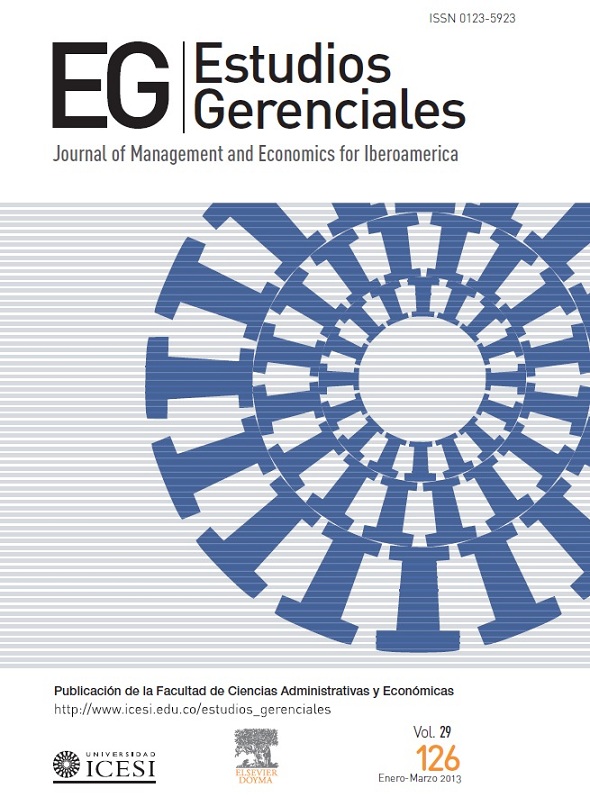Uma equação proposta para fomentar a inovação nas organizações
DOI:
https://doi.org/10.1016/S0123-5923(13)70017-2Palabras clave:
Processo de inovação, equação de fomento da inovação, modelo mental estratégico, desafios e riscos da inovação.Resumen
Pressões da globalização e da disponibilidade de tecnologia têm gerado discussões nos governos, academias e gabinetes dos executivos e CEOs em busca de melhor compreensão dos fatores envolvidos no processo de inovação. Ações da organização para incentivar a inovação parecem não ser suficientes para obter que as pessoas inovem. Este trabalho, através de estudo qualitativo, endereça os fatores envolvidos em experiências de sucesso, para propor que os fatores componentes da equação para fomentar a inovação - ambiente de negócios, organização, gerência, complementadores, e o inovador e seu modelo mental – estão presentes e conclui que, para inovar, a organização deve endereçar esses fatores, mapeando especialmente funcionários com modelo mental estratégico, propício a assumir os desafios e riscos da inovação.
Descargas
Referencias
Alpkan, L., Bulut, C., Gunday, G., Ulusoy, G. & Kilic, K. (2010). Organizational support for intrapreneurship and its interaction with human capital to enhance innovative performance. Management Decision, 48(5), 732.
Amara, N., Landry, R. & Doloreux, D. (2009). Patterns of innovation in knowledge-intensive business services. The Service Industries Journal, 29(4),407-412.
Analoui, F. & Karami, A. (2002). How chief executives' perception of the environment impacts on company performance. The Journal of Management Development, 21(3/4), 290-306.
Bandura, A. (1986). The social foundations of thought and action. New Jersey: Prentice-Hall.
Blumentritt, T. & Danis, W. M. (2006). Business strategy types and innovative practices. Journal of Managerial Issues, 18(2), 274-293.
Brazeal, D.V, Schenkel, M.T. & Azriel, J.A. (2008). Awakening the Entrepreneurial Spirit. New England Journal of Entrepreneurship, 11(1), 9-26.
Bressan, F. & Toledo, G. L. (2011). The marketing MBA professional preferred ment al model and the strategic thinking competence. En M. G. Villena (Chair), Proceedings of the 2011 Balas Annual Conference, Santiago: All Academic.
Campbell, C. A. (1992). A decision theory model for entrepreneurial acts. Entrepreneurship: Theory & Practice, 17(1), 21-27.
Conant, J. S., Mokwa, M. P. & Varadarajan, P. R. (1990). Strategic Types, Distinctive Marketing Competencies and Organizational Performance. Strategic Management Journal, 11(5), 365-383.
Dvir, D., Segev, E. & Shenhar, A. (1993). Technology's varying impact on the success of strategic business units. Strategic Management Journal, 14(2), 151-161.
Frangos, C. A. (2010). What organizational practices drive the structuring and sustaining of innovations: a field study. ProQuest Dissertations and Theses. University of Pennsylvania.
Gallén, T. (2006). Managers and strategic decisions: does the cognitive style matter? The Journal of Management Development, 25(2), 118-134.
Goodale, J. C., Kuratko, D. F., Hornsby, J. S. & Covin, J. G. (2011). Operations management and corporate entrepreneurship. Journal of Operations Management, 29(1/2), 116.
Gupta, V., Macmillan, I. C. & Surie, G. (2004). Entrepreneurial leadership: developing and measuring a cross-cultural construct. Journal of Business Venturing, 19(2), 241-252.
Gurkov, I. (2005) Innovations in Russian Industries: Conditions for Implementation and Impact on Competitiveness. Journal for East European Management Studies, 10(3), 218-247.
Hambrick, D. C. & Mason, P. A. (1984) Upper echelons: the organization as a reflection of its top managers. The Academy of Management Review (pre-1986), 193-206.
Hambrick, D. C., Geletkanycz, M. A. & Fredrickson, J. W. (1993). Top executive commitment to the status quo. Strategic Management Journal, 14(6), 401-418.
Hax, A. C. (2010). The delta model: reinventing your business strategy. Cambridge: Springer.
Hornsby, J. F., Kuratko D. F., Shepherd, D. A. & Bott, J. P. (2009). Managers' corporate entrepreneurial actions. Journal of Business Venturing, 24(3), 236-247.
Ireland, R. D, Kuratko, D. F. & Morris, H. M. (2006). A health audit for corporate entrepreneurship: innovation at all levels- part II. The Journal of Business Strategy, 27(2), 21-31.
Jung, C. G. (1991). Tipos psicológicos. Sao Paulo: Atlas.
Keirsey, D. & Bates, M. (1978) Please understand me: character & temperament types. EE. UU.: Prometheus.
Kroeger, O. & Thuessen, J. (1992). Type talk at work. EE. UU.: DellBooks.
Levering, R. (1997) Um Excelente Lugar Para se Trabalhar. Rio de Janeiro: Qualitymark.
May, R. (1991). A coragem de criar. Rio de Janeiro: Nova Fronteira.
Miles R. E. & Snow, C. C. (1989). Miles and Snow's typology of strategy, perceived environmental uncertainty, and organizational performance. Akron Business and Economic Review, 22.
Miles, R. E. & Snow, C. C. (2003). Organizational Strategy, Structure, and Process. EE. UU.: Stanford University.
Parnell, J. A, Lester, D. I. & Menefee, M. L. (2000). Strategy as a response to organizational uncertainty. Management Decision, 38(8), 520-530.
Porter, M. E. (1998). Vantagem competitiva. Rio de Janeiro: Campus.
Sawhney, M., Wolcott, R. C. & Arroniz, I. (2006). The 12 Different Ways for Companies to Innovate. MIT Sloan Management Review, 47(3), 75.
Shane, S. & Venkataraman S. (2000). The promise of entrepreneurship as a field of research. Academy of Management Review, 25(1), 217-226.
Schumpeter, J. A. (1982). A Teoria do Desenvolvimento Econômico: uma investigação sobre lucros, capital, credito, juro e o ciclo econômico. São Paulo: Nova Cultural.
Shepherd, D. A. & Krueger, N. (2002). An intentions based model of entrepreneurial teams' social cognition. Entrepreneurship Theory & Practice, 27(2), 167-182.
Silva, M. L. R. (1992). Personalidade e escolha profissional: subsídios de Keirsey e Bates para orientação vocacional. Coleção Temas Básicos de Educação e Ensino. São Paulo: EPU.
Srivastava, N. & Agrawal, A. (2010). Factors supporting corporate entrepreneur-ship: an exploratory study. Vision, 14(3), 163-172.
Tieger, P. D. & Tieger, B. (1998). The art of speed reading people. Canadá: Little Brown.
Publicado
Número
Sección
Licencia
Los autores de artículos serán responsables de los mismos, y por tal no comprometen los principios o políticas de la Universidad Icesi ni las del Comité Editorial de la revista Estudios Gerenciales. Los autores autorizan y aceptan la cesión de todos los derechos a la revista Estudios Gerenciales, tanto en su publicación impresa como electrónica. Luego de publicado el artículo, puede ser reproducido sin autorización, mencionando autor(es), título, año, volumen, número y rango de páginas de la publicación, y como fuente: Estudios Gerenciales (abstenerse de usar Revista Estudios Gerenciales).








